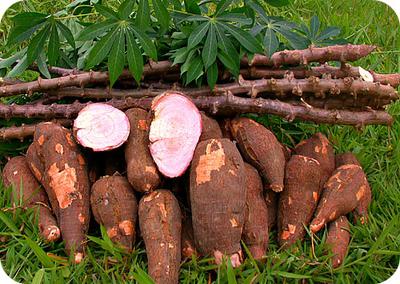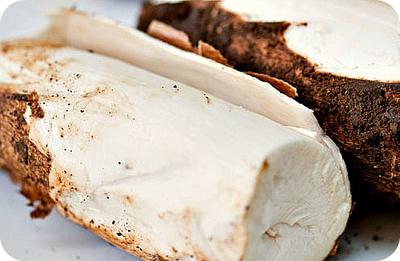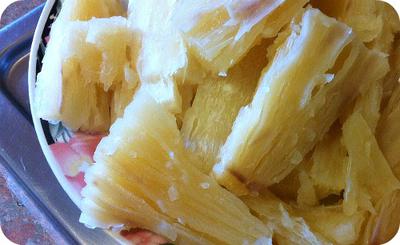VANILLA BEANS | SOYBEAN OIL | SOYMEAL & CAKE | COCOA BEANS | COFFEE BEANS
Cassava Recipes common among Uganda Foods

Raw Cassava Tubers in Uganda
Cassava (Manihot esculenta), is also called manioc, yuca, balinghoy or kamoteng kahoy (in the Philippines), mogo (in Africa), mandioca, tapioca-root (predominantly in India) and manioc root, a woody shrub of the Euphorbiaceae (spurge) family native to South America, is extensively cultivated as an annual crop in tropical and subtropical regions for its edible starchy tuberous root, a major source of carbohydrates. It differs from the similarly spelled yucca, an unrelated fruit-bearing shrub in the Asparagaceae family. Cassava, when dried to a powdery (or pearly) extract, is called tapioca; its fermented, flaky version is named garri.
Cassava is the third largest source of food carbohydrates in the tropics, after rice and maize. Cassava is a major staple food in the developing world, providing a basic diet for over half a billion people. It is one of the most drought tolerant crops, capable of growing on marginal soils. Nigeria is the world's largest producer of cassava, while Thailand is the largest exporting country of dried cassava.
Cassava root is a good source of carbohydrates, but a poor source of protein. A diet consisting predominantly of cassava root can cause protein-energy malnutrition.
Cassava is classified as sweet or bitter. Like other roots and tubers, cassava contains antinutritional factors and toxins.5 It must be properly prepared before consumption. Improper preparation of cassava can leave enough residual cyanide to cause acute cyanide intoxication and goiters, and may even cause ataxia or partial paralysis. Nevertheless, farmers often prefer the bitter varieties because they deter pests, animals, and thieves. The more toxic varieties of cassava are a fall-back resource (a "food security crop") in times of famine in some places.
Cassava Recipes common in Uganda
Cassava used to be grown as food security for the Baganda people because the Casava plant tubers would always remain during Drought/dry season. The people from Masaka (Banamasaka) call it “Mawogo”and those from Kyagwe( Banakyagwe) call it “Muwogo”:
i)Steamed Cassava ( Muwogo omufumbe)
ii)Katoogo: Cassava +Dry or Fresh Beans.Dry beans make it have an appetizing brown reddish colour
iii) Cassava Chips
iv) Cassava Crisps
v) Omugunu: Steamed mashed Cassava +Steamed mashed sweet potatoes
vi) Cassava cheese balls or cakes or croquets
vii)Cassava coated with bater (Baking flour ,Eggs, Salt, (Seasonings +water beaten together)
viii) Cassava Flour (Obuwunga bwa Muwogo)
a) Cassava Bread (Cassava posho)
b) Sweet banana pancakes (Kabalagala)
Click here to request a more Detailed Food Recipe, Foods in Recipe, Meal Planning Services/menus ideas, Cook Training Services
If you haven't yet found what you were looking for or you need detailed information about the subject matter on this page then... feel free to ask our business travel consultants. |









